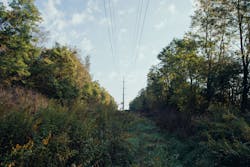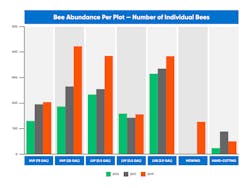Pollinator populations have been declining since the 1990s. Despite this concerning trend, utility rights-of-way provide bountiful landscapes where biodiverse habitat can be developed to support a variety of pollinators.
With the help of Corteva Agriscience and other environmentally minded funding partners, the State Game Lands 33 (SGL 33) research project in central Pennsylvania has studied the impact different vegetation control methods have on floral and faunal species throughout utility rights-of-way. Over the last three years, goals for this research included the collection of flower-visiting insects throughout utility ROW corridors as these sites represent ideal landscapes for pollinator habitat to exist.
The Floral and Faunal Research Report provided by SGL 33 researchers with Pennsylvania State University produced three key findings.
1. Hand-cutting and mowing plots featured a lower abundance of bees than most herbicide-treated plots.
Herbicide-based treatments consistently outperformed hand-cutting and mechanical mowing practices in terms of total bees per plot. Researchers only collected 52 total bees from the hand-cutting plot and 128 bees from the mowing plot. By 2019, the quantity of individual bees on plots to which high-volume foliar (HVF) herbicide application, low volume foliar (LVF) herbicide application and low-volume basal (LVB) herbicide application treatments were applied, significantly outperformed these metrics.
Researchers collected 107 tentative bee taxa at SGL 33 in 2019. The most were collected on the HVF plot to which 25 gallons of herbicide were applied, and the fewest were collected from the hand-cutting plot. Other herbicide-treated plots outperformed mechanical control methods as well:
- Hand-cutting: 26 taxa
- Mechanical mowing: 29 taxa
- HVF (75 gallons): 46 taxa
- HVF (25 gallons): 61 taxa
- LVF (0.5 gallon): 47 taxa
- LVF (0.5 gallon): 53 taxa
- LVB (2.9 gallons): 47 taxa
3. Low-volume basal applications yielded the most consistent results
The LVB unit featured a consistently high abundance and taxa richness of native bees across all three years after treatment. The mechanical mowing plot featured the second-lowest abundance of individual bees next to the hand-cutting plot, and both yielded significantly lower levels of abundance and taxa richness across all three years of study.
Results from the past three years of SGL 33 research add to decades of environmental studies that indicate how selective herbicide applications can be support IVM programs and the development of biodiverse habitat for pollinator species throughout utility rights-of-way. Utility vegetation managers have the ability to not only protect utility infrastructure from encroaching trees and other incompatible plant species, but also support the development of biodiverse habitat for bees and other pollinator species.
As a funding partner of SGL 33 research, Corteva Agriscience launched a digital resource that shares environmental research insights, effective herbicide programs and application success stories with vegetation managers from across the country. For access to these insights, visit HabitatWithHerbicides.com.
™ ® Trademarks of Corteva Agriscience and its affiliated companies. © 2023 Corteva.
Sponsored By:


